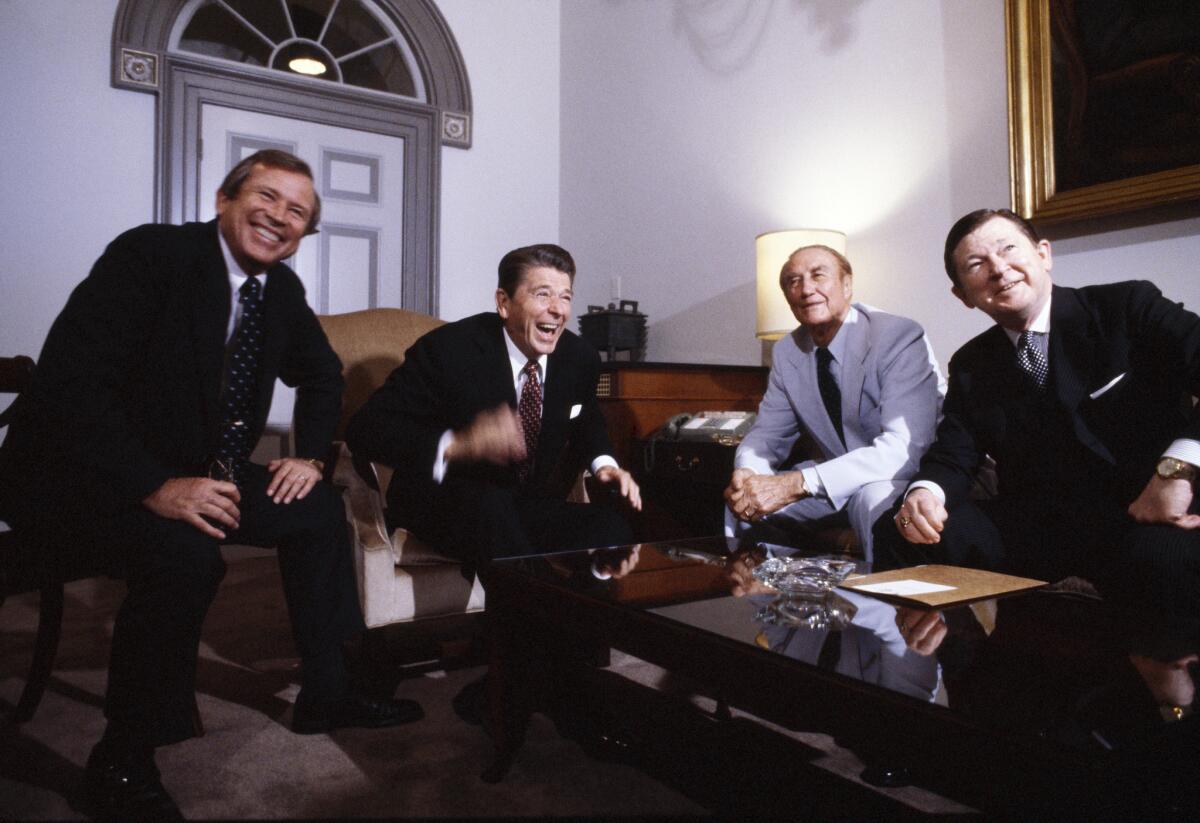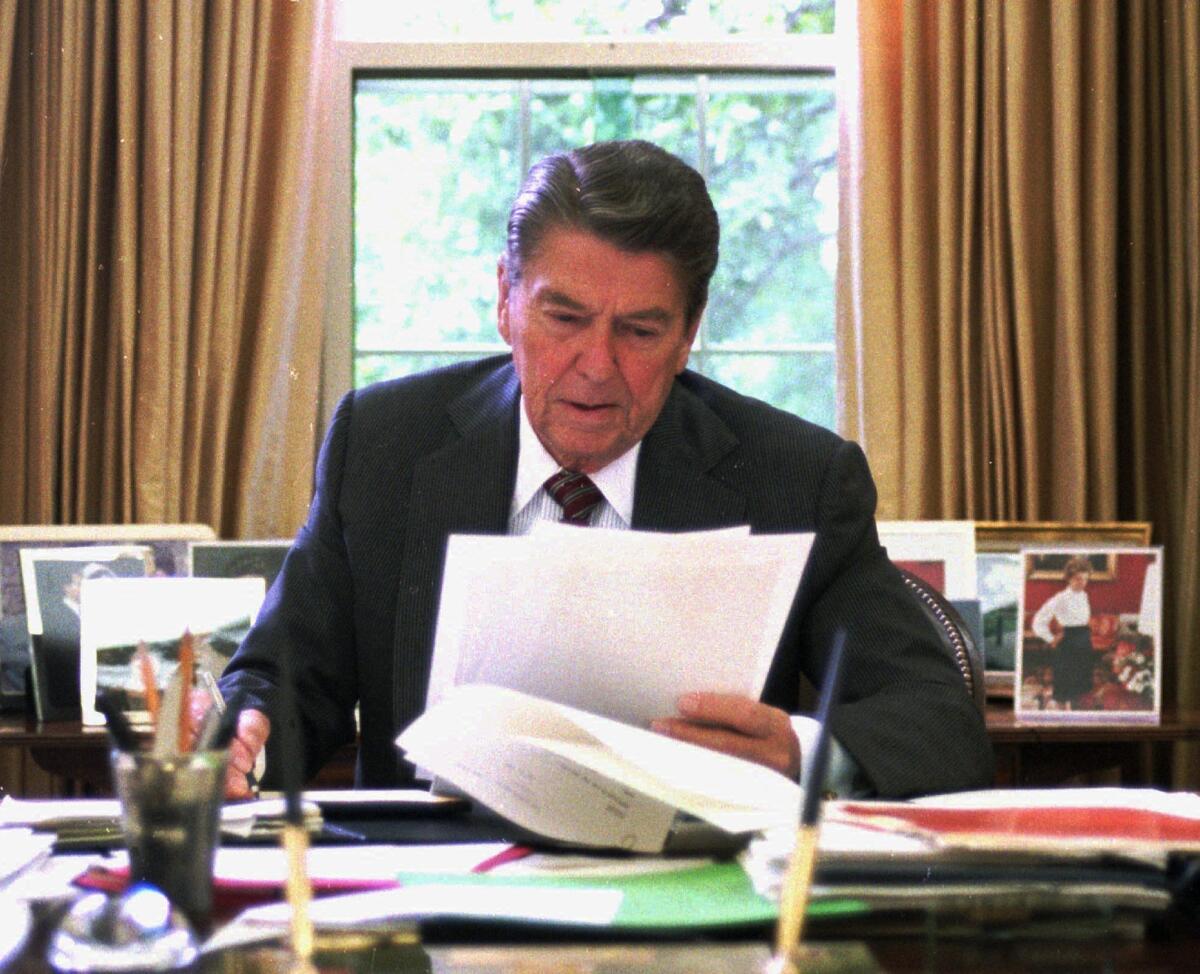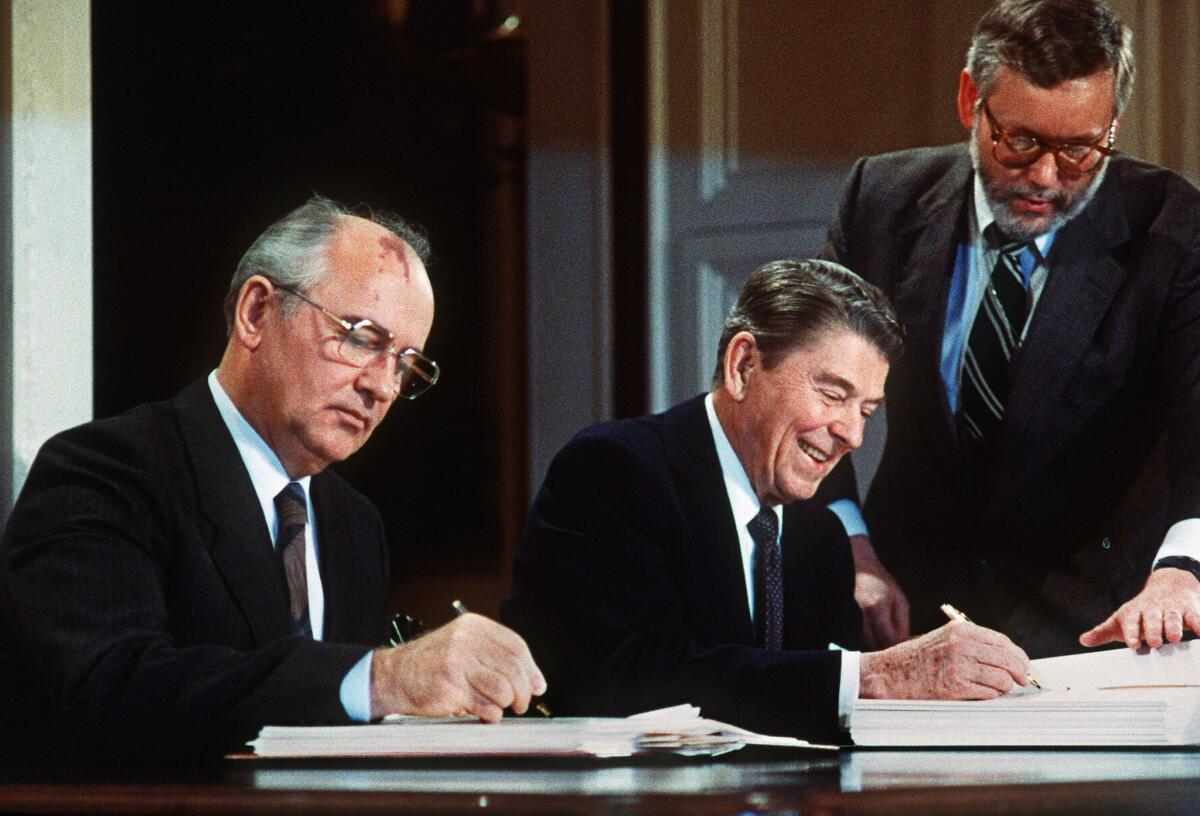A massive new biography of Ronald Reagan forces comparisons to President Trump
- Share via
Publication of Bob Spitz’s massive biography of Ronald Reagan couldn’t have been more timely. In coming out on the eve of the midterm elections, “Reagan: An American Journey” will provide at least preliminary answers to two troubling questions that have by now become almost unavoidable: 1) How does the present occupant of the White House stack up against Reagan, who is (or once was) not far behind Lincoln and TR in the pantheon of historic Republican icons? And 2) Could Reagan, who signed hefty state and federal tax increases; approved the California Therapeutic Abortion Act; OKd IRCA, the federal Immigration Reform and Control Act of 1986, which legalized some 4 million immigrants; and as governor of California signed a set of landmark environmental bills even be nominated by the GOP today?
The answer to the first question: Even in the eyes of this unreconstructed New Dealer, Donald Trump makes Reagan look great. The answer to the second question: Today’s GOP would almost certainly find Reagan too moderate and pragmatic, at times too ready to compromise, to nominate him for almost any major office.
Reagan and Trump have a few things in common. Both began their public lives as entertainers. Both were septuagenarians, or close to it, when sworn in as president. While Reagan had served two terms as California’s governor, neither knew much about foreign policy, or about national affairs for that matter. Neither bothered much about detail. Where Trump gets his ideas from Fox News, Reagan got his from the right wing weekly Human Events and the Reader’s Digest. Again and again, he also retailed stories — about the Chicago “welfare queen” who netted “tax-free income of over $150,000,” or about how the federal government ”underwrote the cost of a study dealing with Polish bisexual frogs” — that had no basis in fact.
But that’s where the similarities end. Reagan, as Spitz makes abundantly clear, cared about his country — sincerely loved it, even though much of his image of that country was stuck in a sentimentalized Norman Rockwell past that never existed. His upbringing, in Spitz’s words, “owed more to the moodier, crisis-filled sagas of, say, Willa Cather or Upton Sinclair than to Mark Twain.” But that’s not how Reagan saw it.
His presidency, despite his pursuit of illusions — supply side economics, properly dismissed by George H.W. Bush, who was then opposing him in the 1980 primaries, as “voodoo economics”; SDI, the Strategic Defense Initiative, a visionary shield to stop enemy missiles in space, soon dubbed “Star Wars,” that probably never had a chance of working; the disastrous stationing of Marines in Lebanon — was never about him, or about personal aggrandizement. He wanted to be a peacemaker. He respected the postwar order and America’s European allies — sometimes, as in his thoughtless acceptance of German Chancellor Helmut Kohl’s invitation to the Bitburg cemetery where some members of the notorious Nazi Waffen-SS were buried, respected them to a fault.
Equally important, Reagan’s sunny personality, his (sometimes excessive) self-confidence and his folksy ability to reach middle Americans seemed to insulate him from the fallout of the policy disasters and embarrassments and the effects of the neglect and mismanagement that so often plagued the White House. The Teflon President.

The outlines of this story will be familiar to political junkies and policy wonks with long memories, but it’s told in lavish detail: from the frequent moves in Reagan’s childhood, mostly forced by father Jack Reagan’s alcoholism and the jobs he lost because of it; to the son’s ascent as a sports broadcaster; his Hollywood career, much of it playing supporting roles in forgettable films, to his negotiating skills as president of the Screen Actors Guild; to his political conversion from Roosevelt Democrat to conservative Republican, the last prompted mostly by the hefty income tax bills that he got shortly after World War II.
It was then that, as host of the General Electric Theater TV program and as a roving GE emissary, he became the man who, as much as anyone, revived American conservatism and the Republican Party after the disasters of Barry Goldwater’s failed presidential run in 1964, Watergate and Richard Nixon’s forced resignation a decade later.
It was a familiar script: lower taxes, smaller government, ”welfare cheats,” militant anti-communism, self-reliant individualism and (in his run for governor) “campus troublemakers.” Reagan and his wealthy Southern California backers, Henry Salvatori, Holmes Tuttle, Justin Dart, Cy Rubel and a few others would eventually parlay those themes into his two terms as governor and, six years later, to the White House.
In each case, luck played no small part. Both Pat Brown, running for a third term as California governor in 1966, and Jimmy Carter, seeking reelection in 1980, had been buffeted by events. In Brown’s case, the Free Speech Movement protests at Berkeley beginning in 1964, and the bloody Watts riot in August 1965, a little over a year before the election; in Carter’s case the storming of the U.S. embassy in Tehran, the hostage crisis that followed and the so-called second energy crisis of 1979.
Spitz tells much of his story with a warts-and-all even-handedness: the jealousies and infighting within the administration, most particularly the animosity between Caspar “Cap” Weinberger, Reagan’s secretary of Defense, and Secretary of State George Shultz, and their sharp differences over the best way to confront the Soviet Union; the Iran-Contra episode in which a rogue operation that the inattentive Reagan may have been unaware of illegally diverted money from the dubious effort to ransom some Western hostages from the ayatollahs in Tehran and spent it on the rebels seeking to topple the Marxist Sandinista government in Nicaragua.
We also learn more about various White House scandals and foul-ups, among them how near Ed Meese, Reagan’s attorney general, came to being prosecuted in an influence-peddling scandal; and Nancy Reagan’s expensive habits, fancy friends and protectiveness of her husband, especially after he was shot early in his first term, as well as her incessant White House meddling, guided often by her astrologer, Joan Quigley.

Sometimes there’s too much detail, sometimes not nearly enough, the focus sharp but narrow. For the most part, the wider world in which Reagan had such a large role is missing. Spitz here is still the celebrity biographer he was with Julia Child, Bob Dylan and the Beatles. We get page after page on who got what part in what movie, who dated whom and who ate with whom in what restaurant. Hollywood gossip columnists Hedda Hopper and Louella Parsons together are named more than two dozen times. Bob Moretti, the Democratic speaker of the California Assembly who negotiated welfare reform with Reagan (and probably got the better of him), is mentioned once.
Unless I missed it, “Big Daddy” Jesse Unruh, the Democratic heavyweight who ran against Reagan when Reagan sought, and won, reelection as governor in 1970, isn’t named at all.
Spitz tells about one gaffe Gov. Pat Brown made in his losing reelection campaign against Reagan in 1966, but nothing about the Watts riots in August 1965 that probably damaged him far more or about Brown’s indecision and dithering over the execution of Caryl Chessman. The passage of California’s Proposition 13 in 1978 and the national tax revolt it set in motion, which surely helped create the climate for Reagan’s election as president in 1980, is never mentioned.
And sometimes Spitz is just flat wrong. California, he writes, was “traditionally a solid Democratic state.” In fact, before Pat Brown was elected in 1958, California had had only one Democratic governor since 1899, Culbert Olson, who served from 1939 to ’43. And the only Democratic presidential candidate who’d carried the state since 1948 was Lyndon Johnson in the landslide of 1964. Spitz says Reagan needed 27 votes in the Assembly to carry a bill. In those days he would have needed 27 in the Senate to pass a budget, 54 in the Assembly. And he gets the geography of Sacramento wrong. The trip from his residence on 45th Street to the Capitol was not north, as he says, but west.

More troublesome is the absence of any extended discussion or analysis of the legacy of a president who was surely one of the towering figures of the latter half of the 20th century. “He made the country feel better about itself; he restored its morale, its self-respect,” Spitz says. But that’s not enough, and, even if correct, didn’t last very long. In June 1987, in a famous speech at the Brandenburg Gate, Reagan had called on Soviet leader Mikhail Gorbachev with whom he’d been negotiating nuclear arms reductions, and who he seemed to get along with, to “tear down this [Berlin] wall,” and in November 1989, less than a year after he left office, the wall came down.
Reagan did not “win” the Cold War, and it wasn’t Gorbachev who tore the wall down, but it was Reagan’s determination to develop SDI, notwithstanding widespread doubts about its feasibility — and despite serious worries that it would destabilize the system of mutual deterrence that had kept the missiles in their silos — that seems to have forced Gorbachev to confront the realities of Russia’s economic and technological implosion. Russia, Gorbachev knew, couldn’t compete, something about which neither Reagan nor U.S. intelligence agencies then seemed to have any clear idea.
Nonetheless, Spitz’s book, relying in part on prior Reagan books, in part on the author’s interviews with old Reagan associates, and in part on a trove of Reagan papers and documents, not only fills in many details but will inevitably also be a significant marker against which to measure our current politics and political leadership. Trump appears only once in Spitz’s book, and not as president, but he hovers over it. Reagan, in his final address to the nation, again talked about America as the “shining city upon a hill” with “people of all kinds living in harmony and peace … and if there had to be city walls, the walls had doors and the doors were open to anyone with the will and heart to get here.” For Trump’s Republican fans, reading Spitz’s book is likely to be an unsettling experience.
Schrag was for many years the editorial page editor of the Sacramento Bee and is the author of “Paradise Lost: California’s Experience, America’s Future” and most recently, “California Fights Back: The Golden State in the Age of Trump.”
::
Bob Spitz
Penguin Press: 880 pp., $35
More to Read
Sign up for our Book Club newsletter
Get the latest news, events and more from the Los Angeles Times Book Club, and help us get L.A. reading and talking.
You may occasionally receive promotional content from the Los Angeles Times.









